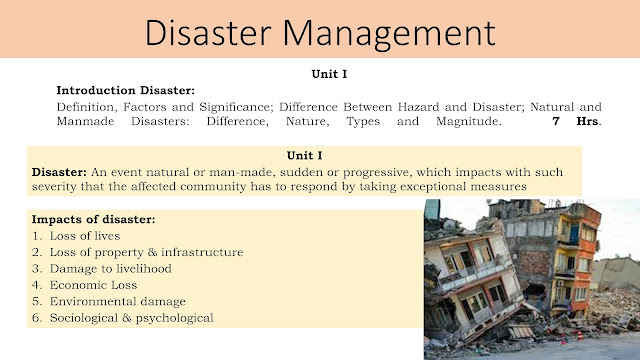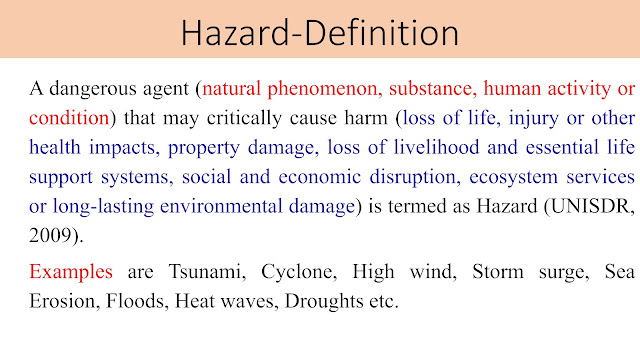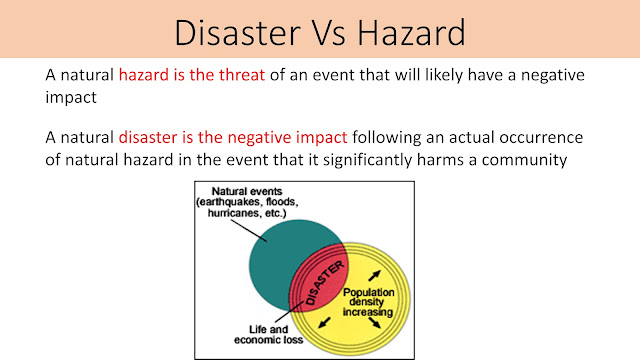Unit 2 IMPACTS/ REPERCUSSIONS OF HAZARDS
2.1 Classification of Disaster impacts
1. Social Impacts due to loss of lives
2. Health impacts
3. Socio-economic impacts
4. Environmental impacts
5. Ecological impacts
2.2 Impacts of Floods
Apart from loss of life (human and cattle) and damage to property, the devastating effects of floods include sense of insecurity and fear in the minds of people living in the flood plains. Other effects include
- agony of survivors,
- spread of epidemics,
- non-availability of essential commodities, and medicines,
- loss of dwellings
- damage of crops
- damage of drinking water wells
- damage of public utilities
2.3 Impacts of Droughts
The impact of droughts may be economical, environmental and social
- Economic impacts
- Loss of crops, which means loss to farmers, and increase od price
- Loss of timber causing losses to timber industry
- Loss of businesses in fisheries, farm equipment, fertilizers, food processing, etc
- Loss in water transportation
- Reduced hydro-power generation
- Environmental impacts
- Loss of fish and wild life habitat
- Loss of foood and drinking water for humans and wild animals
- Migration of men and animals
- Increased stress to endangered species, leading to extinction of loss of biodiversity
- Loss of tress and vegetation
- Loss of reservoirs, lakes, ponds and wetlands
- Increase in ground water depletion and land subsidence
- Reduced water quality
- Increased soil erosion due to winds
- Degraded landscape
- Increased number of fires and loss of forest and human habitat
- Social impacts
- Large scale migration of people, resulting in loss of income, and mental and physical stress
- Health and nutritional problems
- Famine and hunger
- Loss of human and animal life due to heat, hunger and depressions
2.4
Impact of landslides and
avalanches
- Block
river flow, roads and communication lines
- Immense
loss to agricultural production and land area
- Causes series
caualities
- Causes flooding which worsens situation
2.5
Impacts of cyclones
- Physical
damage: The severest damage is caused by the floods, wind forces and storm
surges, land-slides. Weak and light-weight structures razed to the ground.
- Casualities
and public health: Cyclones cause great damage to health. Viral infections
are caused by violent winds. Epidemic diseases such as diarrhoeas,
malaria, cholera, typhoid, jaundice, etc spread very fast.
- Effect on
water supplies: Flood water also causes havoc by contaminating surface
waters and piped water supplies, and results in acute shortage of drinking
water.
- Damage to
crops and food supplies: Cyclones accompanied by violent winds and
torrential rains cause damage to the standing crop and stocked food grains
in the low-lying areas. Sea water flooding increase the salinity and make
the soil unsuitable for cultivation purpose.
- Damage to
communication and transport: The cyclonic winds completely smash the
commmunication and trnasport system.
- Damage to
essential services: The cyclonis winds badly damages and disrupt the essential
services like electricity, sewage disposal and water supply.
2.6
Impacts of Volcanic eruptions
The impacts of Volcanic eruptions are usually
local or regional. Moreover, the changes in ecosystems and environment are
reversible over passage of time
- Due to
volcanic eruption, mammals, birds and many small terrestrial animals are
wided out.
- The gases,
smoke and ash unleashed from the volcano cause sever heat in the area with
temperatures exceeding even 800°C.
2.7
Impacts of Earthquakes
Earthquakes destroy large cities in a
matter of seconds, and may take thousands of human lives.
- In most
earthquakes of high magnitudes or of shallow depth of focus,
- all
communications are destroyed,
- ground
fissures erupt ground water, and
- large
scale flooding caused due to obstructed drainage, building collapse
- Damage
beyond instantaneous damage
- Collapse
of transportation network: Due to damaged roads, rails and airports
- Collapse
of medical facilities: Too many people are injured to various degrees
- Collapse
of electricity, water supply and food supply
- Collapse
of communication systems
- Secondary
causes leading to loss of lives
- Hunger
- Epidemic
- Cold
- Shock &
trauma
- Lack of
medical attention
2.8
Impact of mining
Mining is a man-made activity. Thus, it can
be planned, controlled, and mitigated with systematic efforts. Mining is of two
types: 1. Surface or open cast mining, 2. Under-ground mining. Both these types
involve the following environmental impacts. (Link)
1.
Air pollution: Dust from mining
causes air pollution. The major components of particulate matter in air
pollution are sulfates, nitrates, ammonia, sodium chloride, black carbon,
mineral dust and water. Many of these come from mining activity
2.
Water pollution: The chemicals
released from mining activities cause contamination of soil, groundwater,
surface water. Mining activities cause noise pollution too.
3.
Land subsidence: This can in
turn cause damages to the buildings, surface drains, highways, water and sewage
lines, etc existing on the ground
4.
Land degradation: After mining
is completed, the waste products of mining, known as mine-spoils, are simply
left in their original location. This results in significant land degradation
and pollution in those areas and nearby areas. Mining can cause erosion,
sinkholes, loss of biodiversity, or the contamination of soil, groundwater, and
surface water by chemicals emitted from mining processes. These processes also
affect the atmosphere through carbon emissions which contributes to climate
change
5.
Deforestation: With open cast
mining the overburden, which may be covered in forest, must be removed before
the mining can commence. Although the deforestation due to mining may be small
compared to the total amount it may lead to species extinction if there is a
high level of local endemism
6.
Noise, ground vibrations and
dust pollution. Blasting causes heavy ground vibrations, damages to nearby
structures, buildings, etc, besides causing irritation to the residents
7.
Mining accidents and health
hazards: The dust produced during mining operations is highly injurious to
health and causes diseases related to lungs. Other common diseases are due to high
levels of toxicity and tuberculosis, cough and cold, malaria, diarrohea, skin
diseases, staining of teeth, joint pains, etc
2.9
Impact of water resource
development projects
1. Displacement of people
2. Loss of bio-diversity
3. Deforestation
4. Soil erosion and reservoir sedimentation
5. Water pollution
6. Seismic impacts
7. Effects on monuments and heritage sites
8. Adverse effects of irrigation in command area, like water logging
and soil salinity
9. Adverse effects on health like increased incidence of malaria and
water borne diseases
10. Impact on aquatic life
11. Land loss and change in land use
12. Downstream impacts
13. Air, noise and water pollution during construction
14. Land slides
15. Safety of workers during construction
16. Quarrying
17. Muck generation/ disposal of waste
18. Vibration due to blasting and use of heavy machinery
19. River water polution in the downstream command area due to increased
use of chemical fertilizers and pesticides.
2.10
Impact of Highway projects
1. Hill cutting
2. Impact on flora
3. Impact on fauna
4. Impact on Land and soil
5. Impact on sir quality
6. Noise level
7. Water quality
8. Impact due to establishment of labour camp





























